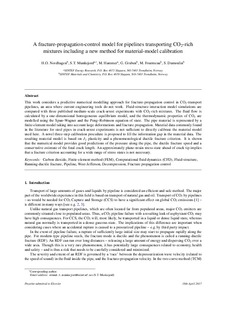| dc.contributor.author | Nordhagen, Håkon Ottar | |
| dc.contributor.author | Munkejord, Svend Tollak | |
| dc.contributor.author | Hammer, Morten | |
| dc.contributor.author | Gruben, Gaute | |
| dc.contributor.author | Fourmeau, Marion | |
| dc.contributor.author | Dumoulin, Stephane | |
| dc.date.accessioned | 2017-11-17T09:41:49Z | |
| dc.date.available | 2017-11-17T09:41:49Z | |
| dc.date.created | 2017-04-20T08:56:38Z | |
| dc.date.issued | 2017 | |
| dc.identifier.citation | Engineering structures. 2017, 143 245-260. | nb_NO |
| dc.identifier.issn | 0141-0296 | |
| dc.identifier.uri | http://hdl.handle.net/11250/2466834 | |
| dc.description.abstract | This work considers a predictive numerical modelling approach for fracture-propagation control in CO2-transport pipelines, an area where current engineering tools do not work. Fluid-structure interaction model simulations are compared with three published medium-scale crack-arrest experiments with CO2-rich mixtures. The fluid flow is calculated by a one-dimensional homogeneous equilibrium model, and the thermodynamic properties of CO2 are modelled using the Span–Wagner and the Peng–Robinson equation of state. The pipe material is represented by a finite-element model taking into account large deformations and fracture propagation. Material data commonly found in the literature for steel pipes in crack-arrest experiments is not sufficient to directly calibrate the material model used here. A novel three-step calibration procedure is proposed to fill the information gap in the material data. The resulting material model is based on J2 plasticity and a phenomenological ductile fracture criterion. It is shown that the numerical model provides good predictions of the pressure along the pipe, the ductile fracture speed and a conservative estimate of the final crack length. An approximately plane-strain stress state ahead of crack tip implies that a fracture criterion accounting for a wide range of stress states is not necessary. | nb_NO |
| dc.language.iso | eng | nb_NO |
| dc.relation.uri | http://www.pvv.org/~stm/research/coupled-co2-n2_preprint.pdf | |
| dc.rights | Navngivelse 4.0 Internasjonal | * |
| dc.rights.uri | http://creativecommons.org/licenses/by/4.0/deed.no | * |
| dc.subject | Karbondioksid | nb_NO |
| dc.subject | Carbon dioxide | nb_NO |
| dc.subject | Trykkavlastning | nb_NO |
| dc.subject | Depressurization | nb_NO |
| dc.subject | CFD | nb_NO |
| dc.subject | Rør | nb_NO |
| dc.subject | Pipelines | nb_NO |
| dc.subject | Elementmetoder | nb_NO |
| dc.subject | Finite element methods | nb_NO |
| dc.title | A fracture-propagation-control model for pipelines transporting CO2-rich mixtures including a new method for material-model calibration | nb_NO |
| dc.type | Journal article | nb_NO |
| dc.type | Peer reviewed | nb_NO |
| dc.description.version | acceptedVersion | nb_NO |
| dc.rights.holder | The Authors have copyright to accepted version | nb_NO |
| dc.source.pagenumber | 245-260 | nb_NO |
| dc.source.volume | 143 | nb_NO |
| dc.source.journal | Engineering structures | nb_NO |
| dc.identifier.doi | 10.1016/j.engstruct.2017.04.015 | |
| dc.identifier.cristin | 1465640 | |
| dc.relation.project | Norges forskningsråd: 193816 | nb_NO |
| cristin.unitcode | 7401,80,6,6 | |
| cristin.unitcode | 7548,60,0,0 | |
| cristin.unitcode | 7401,80,6,0 | |
| cristin.unitcode | 7401,80,64,0 | |
| cristin.unitname | Material- og konstruksjonsmekanikk | |
| cristin.unitname | Gassteknologi | |
| cristin.unitname | Materialer og nanoteknologi | |
| cristin.ispublished | true | |
| cristin.fulltext | postprint | |
| cristin.qualitycode | 2 | |

